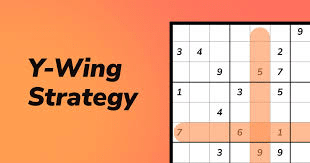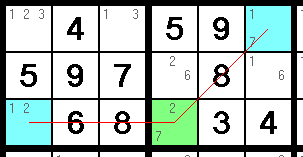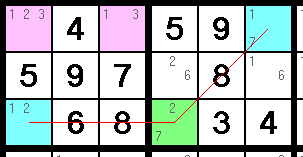XY-Wing Sudoku Technique | Master Sudoku: From Beginner to Expert - Class 1 PDF Download
XY Wing

XY Wing is my favorite technique. I'm not sure why. I guess it's because the logic is just so perfect!
- It's one of those things where, after a little time, I finally came to understand how and why it works, but deep down inside I know I could have never thought it up on my own. It's just too smart!
- That having been said, XY-Wing is not easy to find. But I have devised a method for finding them, and I will pass it on to you a bit later in this page.
First, let me describe what it is.
- In order to follow what is explained below, it is important to first understand the concept of Intersection. Two cells are said to "intersect" if they share a row, column, or block. This of course makes it impossible for them to be the same number.
- XY Wing involves 3 different cells — each with exactly two candidates (pencil marks) — that are related to each other in such a way that you can make some logical conclusions.
- Probably best just to show you. Below is an example of an XY Wing. Note how the 3 cells form a "Y" (see the red lines - it's really more like a "V"). The green cell is the middle, and the two blue cells are the "wings".
 XY Wing is sometimes just called "Y Wing". If you ask me, "V Wing" is more appropriate!
XY Wing is sometimes just called "Y Wing". If you ask me, "V Wing" is more appropriate!
In order for this to work, the cell in the middle of the "Y" (green) must intersect both of the cells on its wings (blue), while the two wing cells may not intersect each other.
Additionally, the green cell's two pencil marks must appear in each of the blue cells' pencil marks, along with a third pencil mark shared by the blue cells only. Notice how the green cell has 2 and 7. Also notice: one of the wings has a 2, and the other, a 7. The other candidate in each of the wings is the same: a 1.
Bear with me, I promise I am going somewhere with this!
Suppose the green cell ended up being "7". This would make the right blue cell a 1. Or perhaps the middle cell is "2"? This would make the left blue cell a 1. In either case, one of the blue cells is going to be 1.
Now that we know with 100% certainty that one of the wing (blue) cells is a 1, we can assume that any cell that intersects both of the blue cells cannot possibly be a 1!
Let's take a look at the same example again:

See two cells colored pink? These two cells intersect both of the blue cells.
Since the green cell dictates that one of the blue cells is going to be "1", we can remove the "1" pencil mark from the pink cells. We have, through logic, eliminated 1 as a candidate for the pink cells.
This creates a Lone Single in the right pink cell, solving it.
OK, you say — pretty cool logic indeed. But how could I ever find a situation like this? Well, I'll tell you — it's a bit easier than it may seem…
If you are working on a puzzle and find yourself stuck — you can find any more naked pairs, hidden singles, or omissions — maybe it's time to look for an XY Wing:
- Start with the top left of the puzzle, working from left to right.
- Focus only on the cells that have exactly 2 pencil marks in them (Sudoklue will highlight these if you press Ctrl-Y)
- For each cell that has two pencil marks, do the following:
- Mentally note the two pencil marks
- Scan that cell's block, column, and row for another cell with one of those pencil marks (remember, only look at cells with two pencil marks)
- For every one you find, you will have a common pencil mark, and two uncommon pencil marks. Now it's time to look for a third cell that has the two uncommon pencil marks. It will need to intersect with one (but not both) of your first two cells. If you find one, you will have found your "Y". Jump down to #4 below.
- Haven't found any? Most of the time you won't. Just move on to the next cell and continue.
- Found three cells? Great! Now figure out which of the three intersects both the others. This will be the "middle". The two others will be the wings.
- The two wings will share a pencil mark that the "middle" cell does not have. This is the candidate we can remove from other cells.
- If you did it right, you will be able to logically assume that one of the two wings will be that number.
So, find any cells that intersect both of them and remove the candidates!
|
9 videos|76 docs
|
FAQs on XY-Wing Sudoku Technique - Master Sudoku: From Beginner to Expert - Class 1
| 1. What is an XY Wing in Sudoku? |  |
| 2. How do you identify an XY Wing structure in a Sudoku puzzle? |  |
| 3. Can you give an example of how to apply the XY Wing technique in a Sudoku puzzle? |  |
| 4. Are there any limitations to using the XY Wing technique? |  |
| 5. How does the XY Wing technique compare to other advanced Sudoku techniques? |  |




















